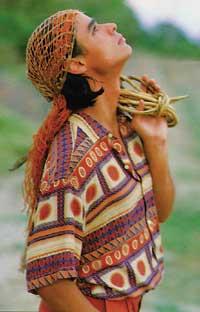Silk? What is going!
The world production of natural fibers is still higher than that of chemical fibers, with 56% and 44% respectively, according to 1994 data. However, the production of chemical fibers can exceed the most natural if, before time, we serve the opinions of experts. For example, cotton production, the main fibre from the productive point of view, has not increased in the last ten years.

And it is that, besides offering some characteristics that the chemical fibers can not offer the natural ones, they are cheap and do not stop depending on the fertility. On the other hand, in the use of chemical fibers has also influenced fashion and, for example, the slogan “wrinkle is elegant” has made a great favor to the production of polyamide fibers, since it allows to manufacture more wrinkled products. Therefore, thanks to the chemical fibers, the fashion designers have enough raw materials to satisfy their aesthetic preferences (touch, texture, fall, etc.). can be adapted as they want.
We constantly talk about chemical fibers and have not yet explained what they are. It is clear what are natural fibres, which are obtained from nature only by mechanical transformation, such as yarn: cotton, silk, jute, etc. The chemical fibers can be artificial or synthetic. Artificial fibres are obtained by the transformation of natural fibers by chemical agents, such as rayon, which is obtained by the treatment of cellulose.
Synthetic fibers are polymeric materials, composed in a broad sense by chemical synthesis. Polymerization processes are used in which small molecules, monomers, bind together to obtain large molecules, polymers, with different physical and chemical properties.
Individual members
If we compare the chemical fibres with the natural fibers, the similarities are seen quickly. In addition, all natural fibers have their chemical component, a chemical fiber of similar characteristics. In the use of fibres, at least, this affinity is clear: wool is replaced by acrylic fibres, silk by polyamide or polyesters, cotton by polyesters and the jute component is polypropylene.
Likewise, affinity not only refers to characteristics but there are other relationships, usually economic, between natural and chemical fibers. Suppose the tailors have extended the fashion of knitwear and that the wool is scarce. This will mean a sustained increase in the production of acrylic fibers.

On the other hand, experts do not consider that new families of chemical fibers are created and, in addition, do not consider that the production of acrylics, polyamide, polyesters and other families of known fibers besides polypropylene is significantly increased. These four types of fibers, in addition to offering a wide spectrum of characteristics, can overcome their shortcomings by means of copolymerization processes (by means of the simultaneous polymerization of two or more types of monomers), mixture of polymers or thermal and mechanical treatment.
Filters of cigarettes
When we give a cigarette pacifier, the cellulose acetate filter will “clean” the smoke that reaches the lungs, since thread of this cellulosic compound is used to make the cigarette filters. Do not think it is a matter of once, since the production of cellulose acetate yarn is one-fifth of all cellulosic fibers.

Cellulose fibers are obtained by the chemical treatment of cellulose through a process called “altercation”, which gives rise to the known tissue known as “rayon”. In a conflicting process a mass of pine wood is first treated with sodium hydroxide. Then add carbon sulfide and allow to macerate the mass forming a cellulose xanthate. The xanthate cellulose solution is a conflicting solution that is diluted “in wet”. The dissolution is passed through the holes of the spinning machine and fiber is obtained by the coagulation of a diluted solution of sulfuric acid cellulose. The process is very polluting and the industry is working to make it more ecological.
The production of these fibers has diminished in the last fifteen to sixteen years, placing the production in 1994 in only two thirds of that of 1980. In addition, if the production has not diminished more, it is due to the informal form of dressing that has spread in recent years. The cellulosic tissues are comfortable and of soft touch.
More diversity
Among the chemical fibers stand out the polyesters. On the one hand, its diversity allows the manufacture of fibres in polyester with very different physical and mechanical characteristics. For example, characteristics of different fibers, such as silk and cotton, can be imitated. This diversity, for its part, affects the production, being the production of polyesters 55% of the production of chemical fibers in 1994. In addition, between 1980 and 1994 the production of polyesters has doubled.
The main polyesters is called poly (etilen tereftalate) (PET), which is recently proposed as a substitute for PVC in bottles and containers of content. The production of PET was distributed in 1994 in 73% of fibers, 15% of content containers, 7% of films and 5% of the rest. PET is synthesized by the reaction of terephthalic acid and ethylene glycol.
One of the most outstanding characteristics of polyester fibres is that its amorphous component is more oriented than in other fibres, which translates into a series of advantages and disadvantages. Among the advantages stands out the slight tendency to ruin and among the disadvantages the need of high temperatures of dyeing.
Polyester fibres are in continuous process of research and development. In recent times, a great effort is being made in obtaining biodegradable polyesters. Logically, these biodegradable polyesters would have very special textile applications. Current biopolyesters are obtained by fermentation, so their production and use are limited. However, the development of genetically engineered plants can open new windows to the biopolyesters market.

Polyesters have made a long way to get fibres like silk. The first generation appeared in the 1960s and imitated its brightness. The second generation fibers, developed in the 1970s, were much better than the previous ones, with an adequate, smooth and volume look. These last two characteristics were obtained by mixing filaments of different contraction in the fiber.
The third generation of silk like products appeared in 1988. Filaments of different contraction are also used in these products, but filaments have surface treatments to obtain porous structures or non-circular sections (see figure). However, the realization of these products is a complex process, in which we must pay attention in all the steps: polymerization, spinning, stretching, mixing of fibres, tricoting, tinting and finishing. Therefore, after all these processes, high-quality products are obtained.
In short, polyesters are used to manufacture fabrics of almost any nature, being the key when devising a suitable process. For example, to achieve tissues with proper fall, organic or inorganic particles are added to the fiber.
Polyamide or nylon, say it as you want
Polyamide fibres or, if you are more ours, nylon is the second largest group of chemical fibers, although in the last decade they have lost relative weight due to the advancement of polyesters. However, its production has increased a quarter between 1980 and 1994 and is expected to continue to grow.
Polyamide was synthesized in the 1930s and pioneered synthetic fibers. They are easy to synthesize and their raw materials are economical. Nylon revolutionized the textile and fashion industry, opening the era of cheaper and varied garments.
There are two main types of nylon: nylon 6 and nylon 66. Although these two nylon are interchangeable in almost all applications, the production of Nylon 6 is higher than that of nylon 66, especially in textile applications, where it is three times higher. The reasons that are hidden are: that caprolactama is cheaper and affordable, that technology is more accessible, that energy consumption is less, etc. In the case of Nylon 6 the monomer is kaprolactama and in Nylon 66 the adypical acid and hexametilendiamine.
The damage that means not giving it

The acrylic fibers that our mothers or grandmothers were puncturing or dolotando at home had the daily raw material. In fact, the “wool” of the trikitixa was in many cases special acrylic fibres, called “high bulk”. Think that the importance of the home point was that 40% of the production of certain production plants was of “high bulk” fiber.
At present, the fact of being so widespread the habit of trikitixa in the home has caused some damage to the production of acrylic fibers, which is stabilized in the last ten years. As a result, acrylic fibers have lost weight in the world of chemical fibers.
Acrylic fibres are synthesized by the polymerization of acryllonitrile and another or other monomers. The second component weighs approximately 8% and is usually one of the following: methacrylate, ethyl acrylate or vinyl acetate. Commoners are quite interchangeable and fibers of similar characteristics can be obtained in both cases. For example, in the last 15 years a European producer has modified three times its comonomer according to its market price.
Polypropylene is not fashion
If you look at the label of your clothes, you will find polyester, polyamide, cotton or written silk, but you will never find polypropylene, since polypropylene fibers are not an object of seams.
In the case of discharge, the production of polypropylene fibers is growing in recent years, more than in any other chemical fiber. It's fashionable, but it's not fashionable. For example, textile experts reject the word “testil” in the case of polypropylene, since behind this adjective is usually understood “fabrics for clothes”.
On the other hand, polypropylene fibre has a great industrial use. The technical fabrics of polypropylene are everywhere, such as coatings or networks of pavements. However, experts do not rule out that in the future polypropylene can be used in the manufacture of clothing. Meanwhile, if you have to deal with the fashion of polypropylene, you will have to wear diving or surfer in the world. Why? Polypropylene fibers are very hydrophobic, that is, they do not absorb water easily and do not stop filtering. Therefore, only in those cases where it is intended to avoid contact with water is polypropylene used for the making of clothing.
It was known that chemical tissues surround us. However, if we look at the label of this plain cotton shirt and see that in the top it says “poli(eztakit zer)”, it will seem to us that they do not surround us and eat us. However, it is not a matter of anguish, especially considering how well these new pants touch you.





